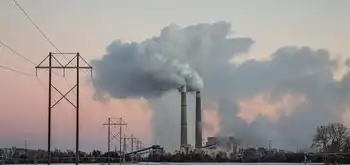Nuclear planning to the year 1,002,008
By Reuters
CSA Z462 Arc Flash Training - Electrical Safety Essentials
Our customized live online or in‑person group training can be delivered to your staff at your location.

- Live Online
- 6 hours Instructor-led
- Group Training Available
The question may sound bizarre but its answer is key to the future of a decades-old, controversial project to store America’s nuclear waste in the belly of Yucca Mountain, on the edge of a nuclear test site and 95 miles from Las Vegas. The narrow road from there winds through a desolate landscape of sparse vegetation — creosote scrub, cactus and gnarled Joshua trees.
“This is probably the world’s most intensely studied mountain,” says Michael Voegele, one of the senior engineers on the project, standing beside the “Yucca Mucker”, a 720-ton cylinder-shaped machine that has drilled a five-mile tunnel into the mountain. “And yet, there will be even more study.”
Indeed. In September, the U.S. Environmental Protection Agency (EPA) revised its original safety standards for what would be the worldÂ’s first deep underground nuclear mausoleum. Those standards were meant to protect the health of people living near Yucca Mountain for 10,000 years from the time the mountain is filled with 70,000 tons of radioactive nuclear waste.
Ten thousand years is roughly twice mankind’s recorded history. But a court in Washington ruled in 2004 that protection should reach farther into the future. The new standards “will protect public health and the environment for 1 million years,” according to the EPA. “The Yucca Mountain facility will open only if it meets EPA’s standards….”
The standards specify that for the first 10,000 years, future residents should not be exposed to more than 15 millirem of radioactivity per year. From year 10,001 to one million, the dose limit is now set at 100 millirem a year.
To put those limits into context: Princeton University estimates that the average American is exposed to 350 millirems per year, from sources that range from X-rays to food. Bananas, for example. (They contain potassium and a radioactive potassium isotope. Eating one or two a day adds up to the radioactivity of a chest x-ray a year).
So is a U.S. government agency engaging in scientific fantasy that sets impossible hurdles to building up nuclear power?
“Our fundamental problem is our strict adherence to this number which is given to us by the EPA,” Allison Macfarlane, one of America’s leading experts on the Yucca Mountain project told a panel on nuclear waste in Washington a few days after the U.S. election. (America’s energy mix and the country’s dependence on foreign oil were major campaign topics.)
“This… number created these huge machinations of making incredibly complex computer models, simulations of what will happen at Yucca Mountain over time. And you know what? Those models are meaningless. We’ve set up this process where we want to say a million years from now we know that Yucca Mountain won’t give anyone a dose of more than 100 millirems a year. And we can’t know that. So we need to rethink that whole process of how we re-evaluate that site.”
Like many other experts, Macfarlane does not consider Yucca Mountain an ideal site for a nuclear cemetery. It is in a seismically active zone, complete with extinct volcanoes. Critics say an earthquake could damage the canisters in which nuclear waste will be kept and release highly toxic radioactive emissions.
Up on the mountain, that prospect is not rated probable. Says Voegele, pointing to large boulders that look as if they are balancing on the ridge: “There’s been no quake strong enough in the past 500,000 years to topple them over. Difficult to see how a quake could shake the mountain.”
At the dawn of the nuclear age, scientists discussed a range of options for the storage of the nuclear waste that began piling up from the military — much of the U.S. naval fleet is powered by nuclear reactors — and civilian power plants. They included burying the material in the ocean floor, placing it in polar ice sheets, and even blasting it into space.
No country has completely solved the problem but there is consensus that “deep geological disposal” is a better option than the present system of storing the waste in above-the-ground containers. In the U.S., radioactive waste is kept at 121 sites in 39 states, all awaiting eventual storage inside the mountain here.
Whether that will ever happen is not clear. Apart from technical considerations, Yucca Mountain faces fierce political opposition, not least from president-elect Barack Obama who has described the project as a multi-billion-dollar mistake and said no U.S. state should be “unfairly burdened with waste from other states.”
That came during the election campaign in a letter to a newspaper in Nevada, a fiercely contested state whose people are almost uniformly opposed to Yucca Mountain.
ObamaÂ’s encouragement of an attitude also known as Nimbyism (from Not in My Backyard) helped him beat his pro-Yucca, pro-nuclear energy Republican rival John McCain.
But the project, based on legislation dating back to 1982, canÂ’t be stopped by presidential fiat. The U.S. Department of Energy submitted an application to the Nuclear Regulatory Commission in September to license Yucca Mountain. That process is expected to last three to four years and includes passing judgment on the one-million-year safety standard.
If all goes well, the facility will open in 2020 at the earliest, more than 20 years behind schedule — a blink of an eye on the geological time scale.











